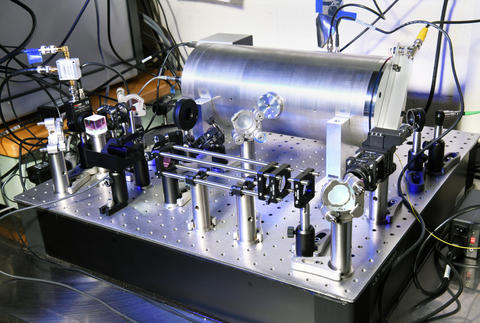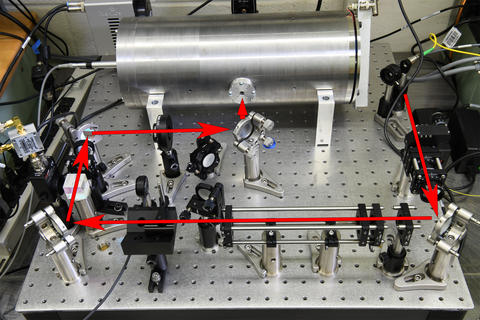Now Hear This!
NIST researchers rely on the interplay between sound waves and light to create what may become a new, more accurate standard for measuring sound.
Researchers at the National Institute of Standards and Technology (NIST) have designed and built an optical device that could set a new standard for measuring the pressure exerted by sound waves—a measure related to their loudness—and for calibrating microphones and other sound sensors.
Improved calibration of microphones can enhance surveillance of nuclear weapons testing, which employs large arrays of sound detectors. It can also boost monitoring and control of noise that could pose a public health hazard at construction sites or around airports and refine the ability to detect air turbulence and enhance aerodynamic testing of mechanical parts.
The optical method relies on the fact that light moves more slowly through denser materials. For example, because glass is denser than air, light traveling through glass travels at just two-thirds its speed in air.
When sound waves move through the air, they alternately compress and expand the gas, changing its density. The variation in density alters both the speed and wavelength of light traveling through the same parcel of air. (The higher the density, the shorter the wavelength.)
To use this opto-acoustic effect as a way to measure the sound waves, the NIST team injects infrared laser light into an optical cavity, 12 centimeters in length, and capped by mirrors on either end. In the absence of sound waves, the length of the optical cavity determines the resonance wavelength, or equivalently, the resonance frequency, of the infrared laser light in the cavity—the frequency at which the light can bounce back and forth many times, in standing waves between the two mirrors before exiting the cavity.
When sound waves are introduced into the cavity, they cause the resonance frequency of the cavity to shift ever so slightly—about 30 parts per billion at a sound pressure of 10 pascals. (The pascal is the unit of pressure in the International System of Units. Standard atmospheric pressure at sea level is around 101,325 pascals.) Because the light bounces between the mirrors several thousand times, the tiny shift is easily detectable. By precisely measuring the shift, the team directly observes the pressure amplitude of the sound waves.


“We are creating a new accurate primary sound standard based on how sound waves affect the wavelength of light,” said NIST researcher Ako Chijioke.
The team plans to apply the technique to calibrating microphones. In ongoing experiments, the researchers place the microphone to be calibrated directly opposite the sound source—a vibrating piezoelectric disc. The optical cavity is positioned to measure the sound pressure. A microphone operates by converting sound into a voltage. By measuring the voltage output of the microphone for a measured sound pressure, the NIST researchers can use the method to calibrate the sensitivity of the microphone. “Although optical cavities have previously been used to detect the presence of sound waves, NIST is one of only a few laboratories investigating the use of the opto-acoustic method to calibrate microphones,” team member Randall Wagner noted.
Continued testing will determine whether the method could ultimately replace the current technique, known as reciprocity, for calibrating sound sensors. The reciprocity method does not directly measure sound pressure. It requires the use of two microphones at a time—one for transmitting sound and one for receiving—and has limited accuracy at sub-audible frequencies below 10 hertz (Hz, or cycles per second) and above 20,000 Hz, the uppermost range of human hearing. The NIST team anticipates that the opto-acoustic technique can provide accurate measurements at these lower and higher frequencies and calibrate a wider range of acoustic devices.
The researchers will report their results at the annual conference on Sound and Vibration to be held in Singapore July 24 to July 28.
Abstract: Akobuije Chijioke, Richard A. Allen, Steven E. Fick, David Long, Benjamin Reschovsky, Jared Strait and Randall P. Wagner. Optical-cavity-based primary sound standard. We propose an optical sound standard in which the sound pressure is directly measured by using an optical cavity to observe the induced change in the refractive index of air. In this method, an optical cavity is coupled with an acoustic cavity, with the device to be calibrated (e.g. a microphone) inserted into one wall of the acoustic cavity. We believe that the method can achieve low-uncertainty measurement of sound pressure in air from infrasonic (e.g. 0.1 Hz) to ultrasonic (e.g. 100 kHz) frequencies. At the lower frequencies a coupler configuration is suitable, in which the sound field is uniform in the acoustic cavity, while at higher frequencies a resonator configuration is suitable, in which a standing sound wave is maintained in the acoustic cavity. The method is also amenable to incorporation into inherently traceable optical microphones, which measure the local sound level by the change in the air refractive index. We have designed a system to measure sound and calibrate microphones at 1 kHz using an acoustic resonator. We are presently constructing this system and will report on experimental progress and our latest results.
ICSV28: 28th International Congress on Sound and Vibration, Singapore, July 24 – July 28, 2022.

